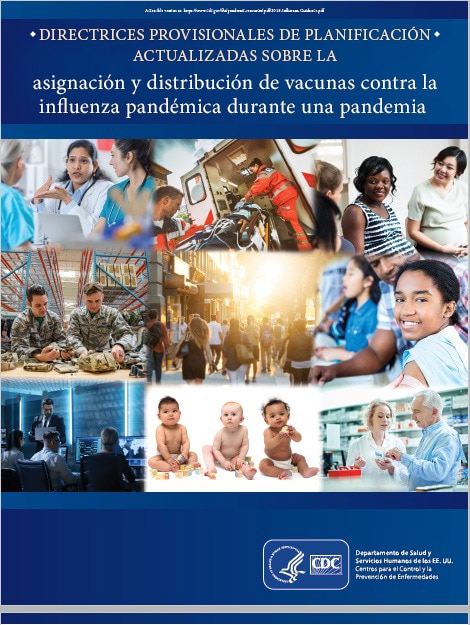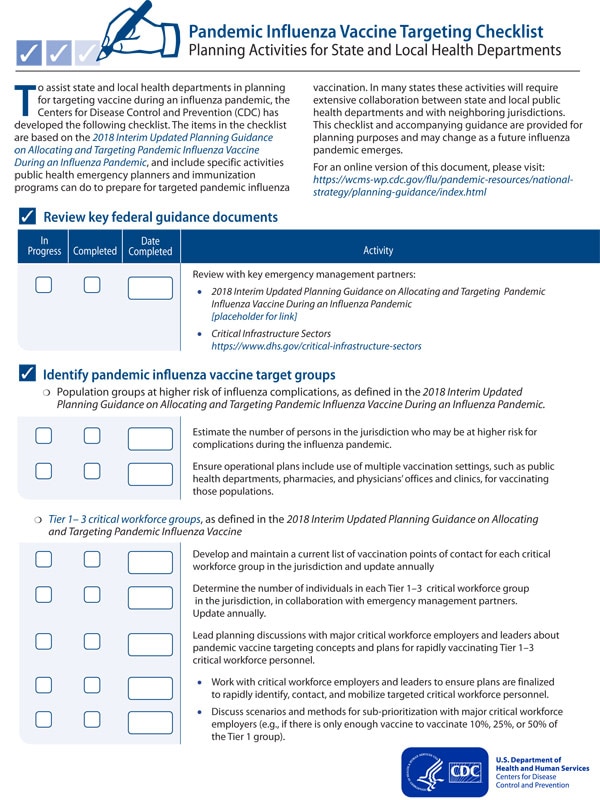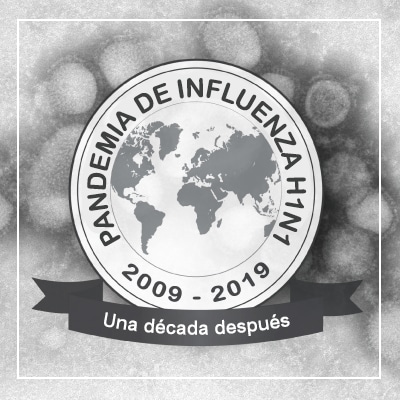Vaccination Tier 2 through 5 by Pandemic Severity

Population groups included in Tiers 2 through 5 will vary depending on pandemic severity (Table 1 and Figure 1). When vaccination has been completed for all five tiers, at any pandemic severity, everyone in the United States will have had the chance to be vaccinated.
Guidance for a pandemic with a high or very high level of severity
Tier 2 targets groups in the homeland and national security category that are critical to maintaining our country’s safety and security. Critical community support service personnel are prioritized because they are needed to assist in a community pandemic response and support vulnerable populations such as the elderly, persons living alone, and households complying with voluntary quarantine when a household member is ill (recommended as part of the community mitigation strategy). Mortuary services personnel also are targeted when excessive fatalities are anticipated and risk overwhelming mortuary services. Critical infrastructure sectors targeted in Tier 2 are those that provide “just-in-time services” (e.g., products like electricity and natural gas that cannot be stored), are relied on by all other infrastructures for their essential operations, and contribute to public health and safety. The highest risk children, whose underlying medical conditions increase their risk of complications or death from influenza infections, and household contacts of infants aged less than 6 months old, are included in this tier.
Tier 3 includes the remaining population groups that protect homeland and national security, provide health care, and maintain critical infrastructures. Critical infrastructure sectors targeted in Tier 3 are those that provide essential products and services where there generally is greater “redundancy” than in Tier 2 in infrastructure (e.g., there are many bakeries, dairies, gas stations) or personnel (e.g., there are many truck drivers); or where burden is likely to decrease in a pandemic (e.g., less demand for mass transit). Many businesses in these sectors can take other measures to protect employees, such as using alternate work schedules, teleworking, and reducing in-person meetings and other contacts in the workplace. In the general population, children without high-risk medical conditions are targeted in this tier.
Tiers 4 and 5 are focused on groups in the general population that have not yet been vaccinated. During a pandemic with a high/ very high level of severity, Tier 4 includes high risk adult populations such as persons aged 19 to 64 years old who have underlying medical conditions and older adults aged 65 years or older. Tier 5 included healthy adults aged 19 – 64 years old.
Because the characteristics of a future pandemic are difficult to predict, planning for a range of options is prudent. In some pandemic scenarios, targeting healthy adults aged 19 to 64 years ahead of those who are older may be appropriate. For instance, in the 2009 H1N1 pandemic, persons born prior to the 1940s had been previously exposed to an H1N1 influenza virus, which was similar to the 2009 H1N1 virus. Thus, older persons were better able to mount an immune responses to the H1N1 virus compared to younger persons. In a pandemic with a high or very high level of severity, vaccinating younger adults first may have several additional advantages: working age adults contribute more to maintenance of societal functions and economic well-being; they provide most care for children; and they often have a higher risk of infection because of their greater number of contacts at work and in the community. Based on these considerations, most of the participants in the public engagement sessions valued vaccinating younger adults before older adults (> 65 years old) in a very severe pandemic. However, given the much higher risk of severe illness and death experienced by older adults in all four of the previous pandemics, plans that target older adults before younger healthy adults would be appropriate in some pandemics. Given these considerations, pandemic planners should consider developing and exercising alternate plans to be prepared to target healthy younger adults over older adults or vice versa, depending on how the pandemic affects these age groups.
Guidance for a pandemic with a moderate level of severity
Moderate level severity pandemics also may pose threats to maintaining security and providing public health, healthcare, and community support services, but (based on experience with the 2009 H1N1 pandemic) will probably not pose a threat to disruption of critical services. As in more severe scenarios, any vaccine targeting effort needs to consider the specific epidemiology of the pandemic.
Population groups in Tier 2 for a moderate pandemic include homeland and national security, health care and community support services, household contacts of young infants, and all children 3 to 18 years old (including those with and without a high risk condition) (Table 1). Because of the large population of children, if vaccine supply is limited, children with medical conditions that increase their risk of severe illness may be vaccinated before those without such conditions.
Tier 3 includes the remaining occupational groups that protect homeland and national security (e.g., active duty personnel not included in higher priority groups and essential support personnel) and persons aged 19 to 64 years who are at higher risk of severe illness due to underlying medical conditions and persons 65 years old and older. Similar to the situation for severe/very severe pandemics, if vaccine supply is limited, younger high-risk adults may be vaccinated before older adults because of the greater vaccine effectiveness in the former group. Healthy adults are included in Tier 4.
Guidance for a pandemic with a low level of severity
A pandemic with a low level of severity poses less threat to community support and other essential services. The greater priority assigned to general population groups relative to occupationally defined groups reflects this shift in the threat to the delivery of essential services. Review of the 2009 H1N1 pandemic indicates that healthcare providers were targeted for receiving vaccine early because of possible occupational exposure, but other essential community services were effectively maintained. Because of this, during a pandemic with a low level of severity, non-healthcare related occupational groups in the community support services critical workforce categories would not be specifically targeted, and workers in these groups would be vaccinated based on their age and health status as part of the general population.
In contrast with more severe pandemics where certain occupational groups are vaccinated before general population groups, in a pandemic with a low level of severity, guidance for targeting of vaccination will likely focus on groups at highest risk of complications from influenza, based on the epidemiology of the outbreak.


